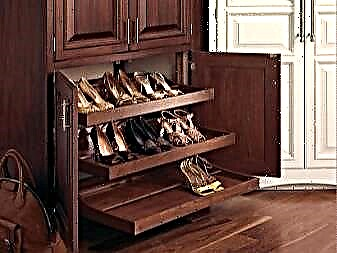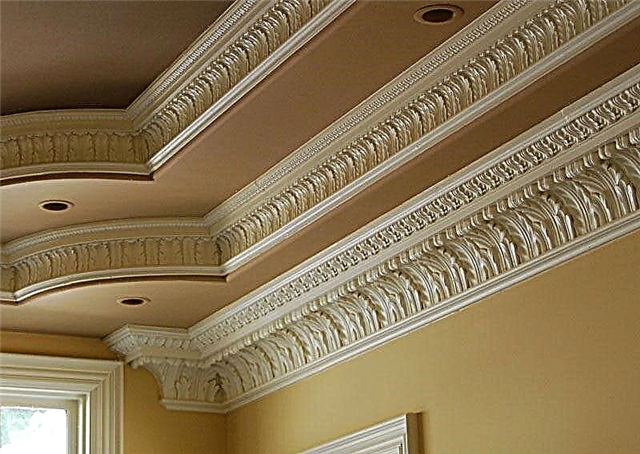 Looking at photos from fashion magazines, almost all “kitchen” images lack refrigerators. Where are they? Are Europeans so rich that they eat exclusively in cafes and neglect food at home? No, there are enough home cookers in Europe, they just chose the built-in models.
Looking at photos from fashion magazines, almost all “kitchen” images lack refrigerators. Where are they? Are Europeans so rich that they eat exclusively in cafes and neglect food at home? No, there are enough home cookers in Europe, they just chose the built-in models.
Pros and cons of the built-in refrigerator
Buying a built-in refrigerator in the kitchen is included in the plans of those who decided to thoroughly study the design and interior of the kitchen. Many negatively relate to a free-standing refrigerator, which destroys harmony and selected colors.
Interestingly, built-in models can be mounted not only in the kitchen, but also in car interiors, office cabinets.
Among the advantages of the products, I would like to highlight the following:
- Consume significantly less electricity due to additional thermal insulation (kitchen cabinet body, etc.),
- They work almost silently
- The main advantage of the refrigerator is stealth. An outsider can hardly guess where the refrigerator is located in the kitchen.
In total, the built-in refrigerator has two drawbacks:
- The volume of the embedded model is much smaller than the analogue solo,
- The high cost of products is more repulsive than attractive.
See also - Know-frost or drip refrigerator - which is better?
Recommendations of specialists on the choice of refrigerators
What are the main criteria when choosing a refrigerator? Correct - conveniently located shelves and compartments for food storage. You should take into account the height of the product - the owner in the kitchen should not get up on socks or on a stool to reach the desired product. Accessible, comfortable, everything at hand - these are the three pillars on the basis of which you should choose a model.
According to experts, the height of the built-in refrigerator should not exceed 2 meters. The recommended parameter is 1.5 meters. If the refrigerator is lower, installation on a stand is recommended.
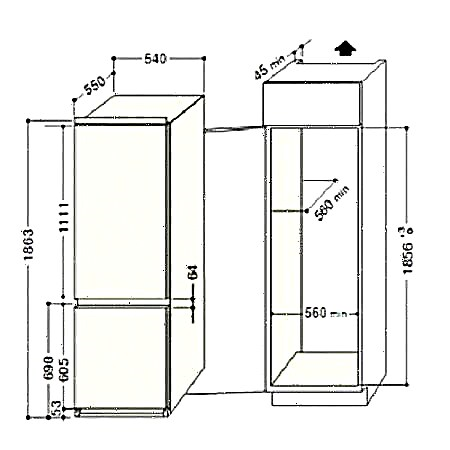
Installation - secrets of installation work
The most important installation parameter is electrical safety. In order for the installation of the refrigerator to go without a hitch, without a hitch, many aspects and rules will have to be studied that will help you complete the procedure in the correct sequence. Each individual model is accompanied by a passport instruction, in which all the recommendations and requirements of the manufacturer are indicated.
Installing a refrigerator is not an easy task. It is necessary that the condenser and compressor are positioned so that fresh air flows freely to them.
Each individual model has its own characteristics, installation nuances and requirements. Do not be guided by the general rules.
When installing the product yourself, you need to pay special attention to the upper gap (above the refrigerator) for the intake of clean air. The gap should be at least 5 cm.

In general, it is not recommended to engage in amateur performances. Built-in appliances must be installed by qualified specialists who know all the nuances of work and give a guarantee for their services.
Any inaccuracy made during the installation of the refrigerator can lead to fatal consequences (namely, damage to the product). To avoid unnecessary costs of repairing or purchasing a new product, entrust the work to professionals.
Design is a repulsive feature of an attractive appliance
Despite its high cost, the built-in refrigerator on the store counter has a modest and unattractive appearance. They do not have a special varnish or chrome coating. The product will get a finished look only after it is mounted in a cabinet and a decorative panel is fixed to its facade. As for the panel itself, it all depends solely on the imagination of the designer. It can be matched strictly in color with a headset, or it can stand out against the general background with its defiant coloring.
When choosing a new built-in refrigerator, it is recommended to pay attention to its characteristics, and not to the appearance.

Summarizing
Built-in refrigerators - ideal for small kitchens. They will not only save space, but also make the room more attractive and convenient. If you do not have the skills of an electrician, it is not recommended to engage in self-installation of the product. Having paid a modest (compared to the cost of the refrigerator) amount, you can order the services of professionals who will quickly and competently perform all the necessary work.
See also - Seal for the refrigerator: replacement or repair?
Types of built-in refrigeration equipment

Built-in refrigeration equipment is divided into partially or fully integrated. Both types of equipment are installed in a separate pencil case. In this case, the fully integrated unit is closed with a decorative panel (door). It opens with the refrigerator door. For appliances that are partially integrated, the facade is usually open or the doors of the unit and furniture are installed independently of each other.
Reference. Not every cabinet is suitable for installing such a technique. Often, pencil cases are made to order, according to the dimensions of a specific model of a household appliance.
Included with the built-in appliances are special fasteners. They are of two types: round hinges and sliding guides. In the first case, the decorative panel is hung on the door of the unit. Its opening takes place together with the facade of the refrigeration equipment, the maximum opening angle is 90 °.
The second method is based on the fact that the unit door moves sideways along the rails when it is opened. There is a gap between it and the decorative panel. The refrigerator door in this case opens within 90 °.
Depending on the layout, embedded equipment is divided into:
- single-chamber - the freezer and the refrigerator are located behind one door,
- two-chamber - compartments are closed with different doors,
- three-chamber - the unit is equipped with a freshness zone with a separate door,
- Side-by-Side - the freezer and the refrigerator are located parallel to each other.
Built-in wine coolers are also on the market. They are distinguished by improved insulation, they support the conditions necessary for storing wine in the chamber - the optimum temperature is from 10 to 12 ° C, humidity is 50-70%. Devices vary in their capacity.

When choosing a technique, they are guided by its availability and comfort. See if the shelves are conveniently located. Take into account the height of the unit.
Reference. The height of the built-in refrigerator, according to experts, should be no more than 2 m. The parameter is considered optimal - 1.5 m.
The internal volume of equipment is selected by the number of users. If one or two people live in the house, they consider the chamber volume to be 120 l or less optimal. 150 liters are enough for three users, 180 liters for four. For a family of five or more people, the recommended chamber volume increases to 300 liters.
When buying a unit, pay attention to the type of control. It is electronic and electromechanical. The electronic system is a touch field with buttons and a display. It allows you to control the device with minimal user intervention. To find faults use the "self-diagnosis" function. A mechanical control system is simpler than an electronic one; it is considered more reliable. It is represented by a regulator of the intensity of work. In two-compressor models there are two of them.

In the household device, two types of compressors are installed: conventional or inverter. The work of the first is cyclical, it is periodically turned on and off. The second type functions without interruptions, maintaining a given temperature regime. It is more durable, economical and less noisy.
Choosing a unit, take into account its energy efficiency. More economical devices are marked with the symbol "A" and "A" with a plus.
When buying, they look what kind of cooling and freezing system the device is equipped with (drip or No Frost). Models with drip thawing are classified as budget ones. They are recommended to be manually defrosted at least twice a year. Equipment with the No Frost system is notable for its high cost - they are looked after as necessary. Take into account the presence of additional functions, such as "supercooling" and "superfrost."
Tip. It is advisable that the equipment be equipped with a sound indicator that notifies you of an open door. This is important if the unit is hidden behind a furniture facade.
What gives the embedding of refrigeration equipment in furniture
Embedded technology has its advantages. It is aesthetically attractive and fits into any interior. The fully integrated unit is hidden behind the decorative panel, it will be difficult for an outsider to guess where it is located. Therefore, it can be installed not only in the kitchen, but also in the living room, study, etc.
Since the refrigerator is mounted in the furniture body, additional thermal insulation is created. As a result, it consumes less energy. It also works almost silently. The built-in unit is compact, it allows you to optimally use the free space of the kitchen, which is important for small rooms.
The disadvantages of built-in refrigerators include high cost. In addition, their volume is less than that of stand-alone models. The back of the equipment is difficult to dust. To carry out cleaning or repair, it is lifted and carried out.
Reference. If there is a need to replace the unit with a larger one, furniture under it will have to be made new.
Is it worth it to embed a regular refrigerator in the headset
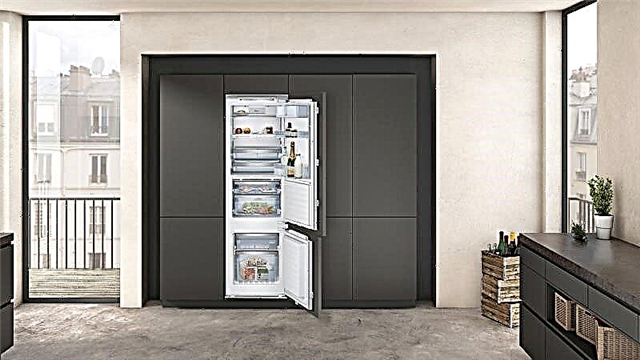
Some craftsmen build ordinary refrigerators in furniture. To do this, they make a special cabinet, on the bottom and back wall of which they make holes. They provide air circulation necessary for thermoregulation of the unit. Or even remove these elements. To ensure the full operation of household appliances, a distance of at least 2 cm is left between it and the cabinet. The furniture door is attached to the refrigerator with a special hinge mechanism.
Such an installation has its drawbacks.. Due to the small amount of air, the unit will heat up, which will lead to its premature failure. The materials from which the furniture is assembled can ignite. If you remove the bottom and back of the cabinet, its stability will decrease, which is unsafe. To fix this problem, the cabinet is attached to the wall, but the air circulation is again hampered.
Since a conventional refrigeration unit has large dimensions, the size of the cabinet will be even larger. It looks bulky and massive. Cabinet doors attached to the refrigerator take up a lot of space when opened. If you assemble furniture with several doors, this will greatly complicate the use of the unit.
Thus, embedding a conventional refrigerator in the headset is possible, but this is not recommended. This will lead to negative consequences. 
How to integrate a refrigerator in a furniture set yourself

Installation of the built-in refrigerator begins with preparatory work. First, the size of the pencil case in which they plan to build the unit, and the size of its doors are calculated. At the same time, the need for ventilation is taken into account: the niche should be higher, wider and deeper than the device. To better circulate air, the rear wall is not mounted. At the bottom, provide ventilation holes or do without it, if the equipment is equipped with legs.
Reference. Recommendations for installing a specific model are indicated in the technical documentation. It gives information on the size of the gaps and provides a diagram of the integration of the built-in refrigerator.
To make a cabinet yourself, the technique is measured. To the results add the ventilation tolerance from the instruction manual (it must be at least 2 cm). Then draw a simple diagram of the installation of the refrigerator. The elementary cabinet consists of sidewalls and a roof. Instead of the back wall, a pair of transverse reinforcing battens or boards are mounted.
When the pencil case is ready (made independently or to order), they begin to install the household appliance. In this case, take into account that:
- the unit must not be installed close to the wall (clearance of at least 5 cm),
- the back of the cabinet should not be placed against a wall with a heating battery,
- it is recommended to install household appliances away from heating appliances,
- the door of the device should open to the maximum width without obstacles.
Tip. A slight inaccuracy during installation leads to damage to the equipment. For this reason, it is recommended to entrust the installation to specialists who know all the details of the process and will give a guarantee for their services.

Self-installation of the built-in refrigerator is as follows:

- The equipment is unpacked, protective films are removed.
- Compare the dimensions of the unit with a pencil case.
- Remove the shipping stops.
- They check the equipment for operability, for this it is connected to the network, it should work quietly and smoothly.
- After checking, the unit is disconnected from the network and installed in its constant place, leaving space in front of the facade for the door.
- Position and secure the wires.
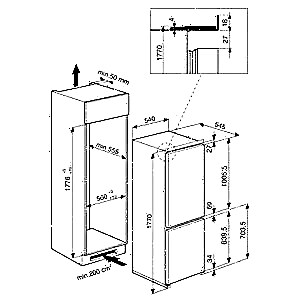
- Check that the horizontal and vertical level was observed, the vertical position is adjusted using bolts located on the bottom.
- If fixing is required, foam gaskets are installed between the walls of the cabinet and the equipment.
- Then you should put the facade panel and mounting elements, and then check the stability of the structure.
- After installation is completed, the unit is plugged into the network and its performance is checked.
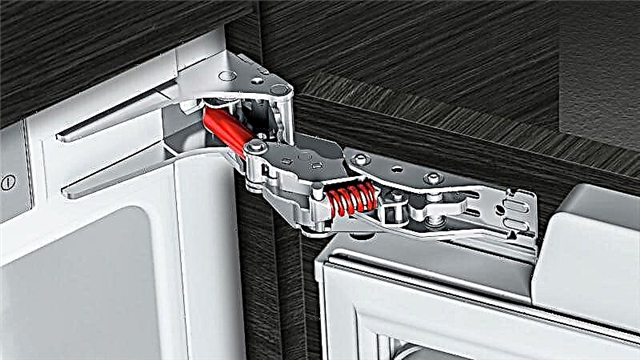
The intricacies of connecting built-in refrigerators
Before installing the refrigerator, pay attention to the location and power of the outlet. They recommend using a separate outlet with grounding. In order not to impede access to it, it must not be placed behind the unit. The best solution is the space under the countertop.
If necessary, lay separate wiring from the distribution panel. The cross section of the wire is selected relative to the power consumption - it is indicated in the operating instructions for the device.
Reference. If several household appliances are installed in the kitchen, then the wire is selected so as to provide a total load.
Conclusion
The installation of the built-in refrigeration unit is best entrusted to specialists. Self-installation requires a responsible approach, special knowledge and skills. It is important to take into account the presence of ventilation gaps, not to install the unit near heating appliances and to correctly connect it to the mains. Even a slight inaccuracy during installation can lead to damage to the equipment. It will be removed from warranty service and the refrigerator will have to be repaired at its own expense.
Installation requirements
The procedure for installing the built-in refrigerator is made in a specialized case, which is included in the overall design of the kitchen set and has the same design. There is a door on the front surface of this item. In most cases, it connects to the refrigerator compartment door. As a result, when you open the cabinet, the refrigerator compartment also opens. In simpler headset models, doors open separately from refrigeration equipment. In such a situation, the housing is called partially embedded.

The pencil case must have a special design that effectively removes thermal energy from a functioning refrigerator. To do this, the following conditions must be met:
- The pencil case is mounted so that between the walls of the cabinet and the device there is a 2-3-cm gap. This will ensure efficient air circulation.
- The back surface of the pencil case should not be closed.
- At the bottom of the cabinet is a shelf with several through holes for ventilation.
Choosing a place for mounting a pencil case is necessary taking into account the general requirements and the installation scheme, which are reflected in the manual for use of the unit. If the refrigerator has a built-in housing, the following rules must be observed during its installation:
- The cabinet must be placed so that the installation of the unit in it provides a distance of 2-3 cm from the rear surface of the unit to the kitchen wall.
- The selected location should provide free opening / closing of the doors at a maximum angle.
- The rear surface of the cabinet must not rest against heating radiators. There should not be other sources of thermal energy.
Mains connection
Before installing a kitchen set, you need to choose a connection point for the future refrigerator. For this purpose, it is better to use a separate electrical outlet with good grounding. The cable cross-section must be selected taking into account the load. If several electrical outlets for electrical equipment are installed, the cross-section of the power cables must be selected taking into account the total power. Outlets are best created in hidden but accessible places. For example, you can put them under the countertop.
Installation process
To install the built-in refrigerator, you need to go through several steps. The main ones are:
- If you just need to replace the equipment with new equipment, first you need to remove the old unit from the cabinet.
- After that, unpack new refrigeration equipment and dismantle the fastener for transportation. Then you should check the dimensions of the cabinet and the appliance.
- Before connecting the refrigerator to the mains, it must be carefully inspected for damage. At this stage, the device must be connected to the network and tested for its operability.
- If necessary, reinstall the door hinges.
- After that, the installation of the built-in unit is carried out. With such work, it is advisable to use the construction level so that no problems arise in the future. Proper installation of the equipment is achieved by turning the regulator bolts, which are located on the bottom surface of the built-in refrigerator.
- In some cases, for reliable fastening, installation of foam gaskets is required. They can be discreetly placed in the voids between the pencil case and the walls of the unit.
- After the installation of the facade, installation of mounting elements is carried out. Then you should check the serviceability of the doors and the overall stability of the equipment.
- The final stage of installation involves the launch and testing of the refrigeration unit.
Self-assembly of the built-in refrigerator requires some knowledge and skills from the contractor. If you have any doubts about the success of this undertaking, it is better to contact specialists who will complete the installation quickly and efficiently. In addition, experts give a guarantee on their work, therefore, in case of any malfunctions, they will be able to eliminate them for free.
Outer door
Installation of facade elements on a refrigerator of a built-in type is a mandatory manipulation. Simplified installation is possible only when the unit is located with a door made of decorative material or special glass. Bosch, Siemens, LG and Liebherr represent such models on the market. By choosing such refrigeration equipment, you can avoid installing additional facades.

The installation of facade surfaces on the built-in refrigerator can be done using special fittings or a fixed fastener equipped with an articulated-roller system. The second option is considered the most reliable, but it is associated with additional financial costs and the complexity of the installation.
Stage 4. We delve into the nuances of installation
It is worth mentioning right away that installing an integrated refrigerator will not be difficult if the furniture was originally designed for a specific model or if the model was selected for an existing niche. In this case, the installation can be carried out independently using the wiring diagram supplied by the manufacturer. If it is required to remodel the furniture set globally, then it is worth taking the help of specialized specialists.
There are a number of general requirements for installing an embedded refrigerator:
- Near the oven, or close to the walls of the cabinet, the refrigerator is not mounted. In order for the air necessary for cooling to circulate freely, at least 7 cm is left on each side of the housing.
- Convenient and durable fastening on the doors is necessarily provided, because according to statistics the refrigerator opens dozens of times during the day.
- The cabinet into which the installation is carried out must be level, only then the hinges and doors will be installed correctly.
Be sure to pay attention to the door hanging system. To completely hide the refrigerator in the kitchen cabinet, use a double door system with various ways of attaching the facade to the door
It can open along sliding guides, like on rails, however in this case there is a gap between the doors where dirt can get, which you will have to regularly clean. This method allows you to open the door at a maximum right angle. If you hang the door with hinges, then the furniture facade will be adjacent to the door of the refrigerator, and the door itself will open the refrigerator much wider.
If it matters to you in which direction the door will open, then it is best to choose a built-in refrigerator with a rearranged door.
See the material for instructions on how to install a regular refrigerator: How to integrate a regular refrigerator into a headset
- How to defrost a refrigerator correctly and quickly in 8 steps
- How to wash your refrigerator in 7 steps and eliminate odors with 8 home remedies
- How to get rid of mold in the refrigerator
- A step-by-step guide for choosing a juicer
- We choose the built-in appliances for the kitchen
- Install the oven
- How to Choose a Gas Hob - A 5-Step Buyer Guide
Installation options
The most important rule: first we choose a refrigerator, and only then we order a cabinet. No qualified craftsman will undertake the installation of built-in appliances in furniture that was purchased without measurements

Some owners, trying to save some money, are trying to build a conventional refrigerator in the cupboard. You do not need to do this:
- In this case, the cabinet will have to be made without a bottom, because an ordinary refrigerator is placed on the floor. Given the fact that the cabinet will not have a back wall either (since other important parts of the refrigerator are located at the back), we get a flimsy design of three boards. It can fall at any time and will swing when the door is opened.
- Even for the most “slim” fridge-solo you will need a huge cabinet. Compared to other lockers, the headset will stand out in size. "Deception" will be revealed.
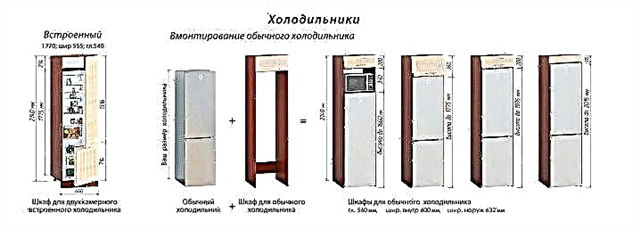
If you really do not want to spend money on a built-in model, you can hide an ordinary refrigerator in a closet. However, it should be without a top cover for free air access.
And the door should be designed for repeated opening.
It is very important to consider the ergonomics of the future refrigerator. If the hostess is small, you should not purchase a tall cabinet, which will be difficult to open
According to experts, the optimal height is 1.7 meters, taking into account the freezer.

So, having decided on the model of the refrigerator, you need to choose a place for it. Here the rules are the same as for simple devices. It must be placed far from the stove and other heating appliances. The space under the cabinet should be perfectly flat
It is very important that the door, along with the cabinet front, open easily and completely - a place must be provided for this
Most often, the refrigerator in the cabinet is placed at the edge of the headset - angular or straight. It is the highest point in the interior, and the rest of the “drawing” is at the level of the belt. However, there are other interesting layout options.

In particular, the refrigerator can be hidden in a cabinet under the worktop. For this purpose, they usually purchase two small, up to 80 cm tall units and put them next to each other. You can divide them thematically, for example, on the right side - meat and dairy products, on the left - fruits and vegetables. It looks original, very unusual and avoids a drop in height in the interior. There will be little storage space for products, of course. In addition, to get something, every time you have to bend over or squat.
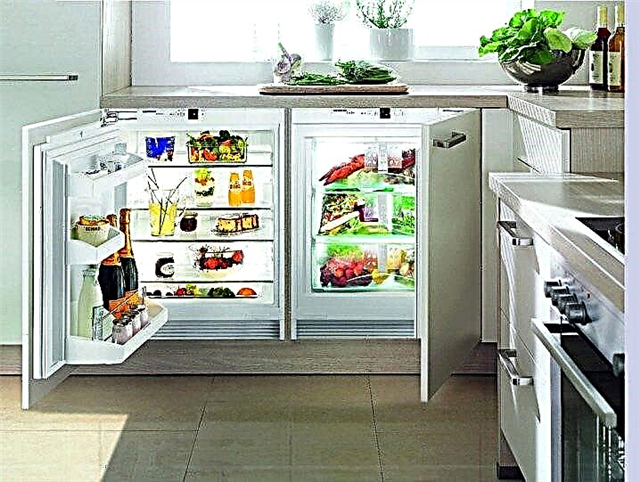
An additional place for storing food (canned goods, preserves, etc.) can be equipped under the windowsill. In many old houses in the kitchens there are special niches that are popularly called the "Khrushchev refrigerator." This is a fairly large recess in the wall with shelves. It has technological holes that allow it to maintain a cool temperature: in winter you can even freeze dumplings. In the 50-60s, this allowed many people who did not have refrigerators to store perishable products without spending any electricity.

Many owners are now blocking them so that the apartment is warmer. However, if you put in new doors (similar to plastic windows) and close the excess slots with foam, you get a wonderful additional built-in refrigerator. Sometimes the doors are made transparent - the appearance of jars of jam or pickled cucumbers creates a special cosiness.

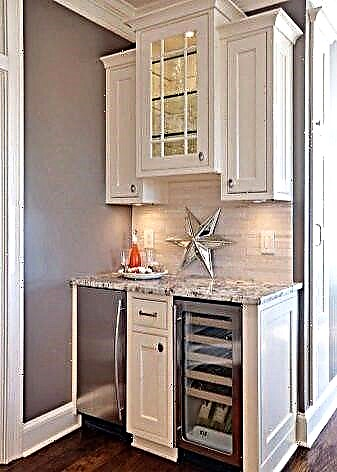
Cooktops for compact and large kitchens ↑
The real salvation for small kitchens and the decoration for spacious kitchens - cooking hobs. Surface sizes - from compact, 2 burners, to large panels of 6 to 8 burners.
Cooktops
The main types of panels:

Standard size gas panel
Gas panels are connected to the outlet of the gas pipe. The number of burners - from two. An excellent choice for small kitchens where food is prepared for 1 - 2 people. The minimum width is only 28 cm. Such narrow plates are suitable for headsets with reduced depth and length, which are made to order. Alternatively, 2 cooking hobs with minimum dimensions can be integrated in series - the number of burners will double.

Narrow glass ceramic stove with gas burners
The cost of panels with gas burners depends on the materials used to manufacture the grill, burners and coating. Saving is not worth it. Choose devices with massive gratings made of cast iron or strong steel. Thin rods of a budget grate are deformed in a few months, and it is difficult to buy a grate for a non-standard slab separately. Most gas surfaces are coated with an enameled decorative layer. Among the popular models are metal panels made of stainless steel.

Custom touch panel electrical panel
Electric cookers are available in more design options. The top panel can be made of tempered glass or glass ceramics. The advantage of glass surfaces is their impeccable appearance and ease of cleaning.

Features of electrical panels:
- It is necessary to use dishes with a perfectly flat bottom.
- The surface must be protected from bumps and falling sharp objects.
- The liquid spilled onto the panel must be removed immediately - sugar leaves indelible marks on the surface of glass and glass ceramics.

Induction cooker always stays cold
The most expensive and modern are induction panels. When the heating is on, the surface of the panel remains cold, and only the dishes are heated. True, for cooking on such a stove you will have to use special dishes.

Multifunctional compact panel
Standard electric panels are also equipped with zone heating. The surface is heated only along the radius of the heating element, the remaining area of the panel remains cold.
Installation of gas or electric hobs begins with a choice of sizes. The standard countertop is 60 cm wide. Almost any model can be built in with your own hands.

Insert countertop marking
Manufacturers complete the equipment with a stencil template for marking the surface for the insert. It is enough to circle the contour with a marker. Cut a hole in a chipboard or MDF plate with an electric jigsaw.

Preparing the installation site
The gas panel is connected to a gas pipe outlet. Use of flexible gas pipes is allowed. The joints must be sealed with sealing tape and checked for gas leaks.
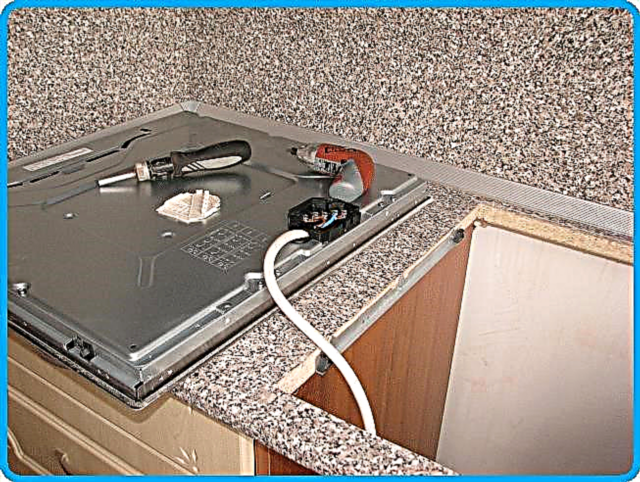
Connecting the wire to the panel
Electrical panels are connected to the mains. Depending on the power, they select a wire with an optimal cross-section. Use ground outlets.

Sealing before installation
After checking the connection, you can fix the panel in the countertop. Additionally, it is recommended to strengthen the sealant fixation.
Possible ideas: how to hide the refrigerator in a cupboard in the kitchen
The main idea is to pick up a drawer that would not look catchy and distinctive from the design of your kitchen.
A protruding handle for opening immediately catches your eye and gives out a "secret" that there is something behind the door. It is recommended to use special invisible handles. They are almost imperceptible and practical to use, which will add more adaptability to your kitchen.

If you have enough space, you can use soundproof materials (they require more space) for upholstery of the cabinet structure, which will significantly reduce the overall noise level.
 You can install special lighting with a battery inside the box, which will allow you to comfortably take food from the refrigerator, even if you have problems with the power supply (the light went out).
You can install special lighting with a battery inside the box, which will allow you to comfortably take food from the refrigerator, even if you have problems with the power supply (the light went out).
What you need to build a refrigerator in the cabinet
 Access to the power grid. The first thing you need is to solve the problem with wiring and free access to the outlet in advance. Buy an extension cord with a supply of wire that will allow for future shifts.
Access to the power grid. The first thing you need is to solve the problem with wiring and free access to the outlet in advance. Buy an extension cord with a supply of wire that will allow for future shifts.
Physical strength to produce the installation process. It is better to share this task with a partner (or even with a large number of workers). Pre-defrost the refrigerator better, which will reduce its total weight. Lifting heavy household appliances is better with jacks.
We make a recessed refrigerator from an ordinary refrigerator
There are four ways to modernize the kitchen design with the integrated device:
- Buy custom made kitchen set for the refrigeration unit.
- Install a household appliance between furniture.
- Change the design of the doors and side walls so that the refrigeration unit fits into the overall design.
- Make a cabinet for a household appliance.
The first option is suitable for those who are ready to part with a large sum for the convenience and aesthetics of the kitchen. With careful preliminary measurements and selected finishes, the appliance will fit the interior of the kitchen. The downside is the high cost of transforming space.
The second method is less expensive, however, you will need to remove one of the elements of the headset. This, in turn, will violate the functionality of the furniture set.
It’s easy to hide the refrigerator, giving it a door with walls of furniture. However, to make it completely invisible does not work.
The option with the manufacture of the cabinet is used by those who know how to wield a hammer, drill, and other tools. The main costs are spent on time and supplies.
Types and features of the facades of cabinets for a refrigerator
The facade of the cabinet for the refrigerator is its front surface (door). It is she who determines the appearance of the structure.

In furniture for ordinary refrigerators, one of two types of facade is used:
- open is a cabinet without doors. It leaves the front panel of the equipment completely visible. It is desirable that it be equipped with a podium and reinforcing elements,
- closed - in this case, doors are attached to the frame. This is not the most convenient option, because to get to the contents of the refrigerator, you will first have to open the cabinet door, and then the device door.

In cabinets designed specifically for installation, a closed facade is used, which is attached to the frame in one of the following ways:
- pantograph system or mount with hinges,
- hanging system on runners or fastening with guides.
The pantograph system involves attaching the cabinet door directly to the refrigerator door. Its advantages include:
- lack of gaps between the doors,
- it does not require synchronization when opening,
- provides maximum opening angle.

The only drawback of this solution is the presence of unreliable internal plastic parts - if heavy objects are stored on the door of the refrigerator, then one of the fasteners will become unusable, and the second one will have to be changed with it. This is due to the uneven load distribution on the refrigerator door.

The hinge system eliminates this problem due to the special fastening and synchronization of the parallel opening. The load is evenly distributed between the cabinet and refrigerator doors.

The disadvantages of the hinge system are:
- the presence of a gap between the doors, where dirt accumulates over time,
- opening angle no more than 90,
- sophisticated mount design.
Built-in appliances: a tribute to fashion or a must-have for modern kitchen ↑
Built-in kitchen appliances do not functionally differ from classic models installed separately. The manufacturer can add additional functions to the standard functions. The built-in technique is radically different only in size, the absence of external decorative side and rear panels, and equipment for fixing inside the headset.

Can integrated kitchen appliances really save space in a cramped room? In fact, the dimensions of the devices range from ultra compact to well above standard sizes. Benefits:
Space saving due to separate placement of hobs and ovens.
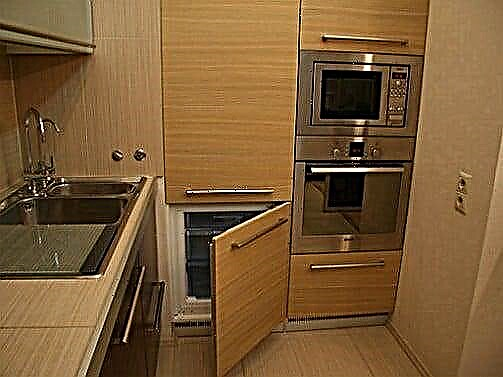
Ergonomic compact space
Aesthetics and solidity of the kitchen interior.
Huge selection of faceplate design options.
Solutions for any style
Compact models are suitable for installation in non-standard headsets with reduced depth.
There is only one drawback of equipment: after installation, it is already impossible to change the configuration and arrangement of equipment and furniture. A cabinet for built-in appliances in the kitchen will have to be completely redone, including replacing the facade.

Front panels to match the facade of furniture
Naturally, the pay for personality is high. A set of built-in appliances for cooking will cost more than a gas or electric stove with a similar set of functions.
The number of devices that can be hidden behind furniture facades depends only on the budget for equipment and the dimensions of the room. Most popular equipment:
Hob, the dimensions of which are determined by the number of burners.
An oven installed under the hob or in a tall cabinet.
Hood, masked by the upper tier cabinet.

Classic set of built-in appliances
In tiny kitchens, you can free up another meter of space if, instead of a classic refrigerator, 2 separate refrigerators are built into the headset: a freezer and a storage area with a temperature of about 0 °.
In the cupboard for kitchen appliances, you can simultaneously integrate both the oven and the microwave - you do not have to look for a place for a microwave on the countertop.
Manufacturers of small kitchen appliances offer built-in models for all popular appliances. Inside the drawers, behind the facades, in the cabinets, bread machines, coffee machines, mixers and combines find their place.
Before you go to the store, clearly define your own needs for technology. After talking with managers, you will want to buy a lot of excess. Agree, it makes no sense to fix equipment inside the furniture that is used every few months.

Big kitchens have more room for installing appliances
Select the dimensions and functionality of the selected technique based on the standard list of dishes that are prepared regularly. Determine the volume of the oven, the internal refrigerator, taking into account the number of family members: why pay extra for a roomy freezer, which will be half empty? Remember that cabinets for kitchen appliances take the usable area from the drawers for storing dishes.
The minimum set of equipment for compact kitchens in apartments:
Oven and hob.
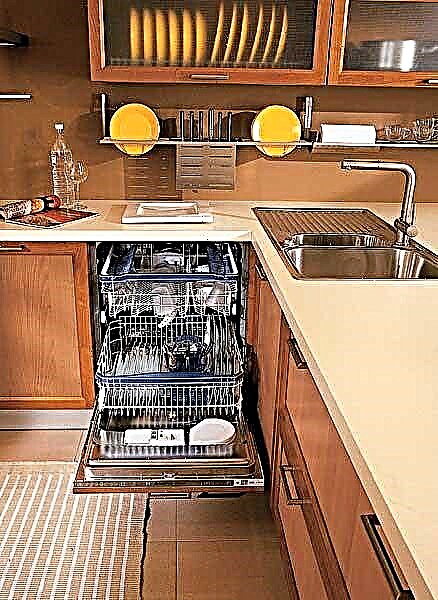
Disguised dishwasher
If the size of the room allows, it is advisable to install a dishwasher, especially if a family of 3-4 people regularly gathers at the table. A useful appliance that is installed in the sink is a waste shredder. In addition to disposing of food debris entering the sink, the equipment will save the kitchen from the appearance of an unpleasant odor from the siphon.
In small city apartments, it is often necessary to install a washing machine in the kitchen - built-in models are ideal.

A washing machine can also be found in a cramped kitchen.
Coffee lovers will be happy to complement the kit with a built-in espresso and latte machine: the coffee maker does not take up much space.

Coffee machine in the cupboard
Cabinet making
Before manufacturing the box for the built-in refrigerator, the following tools, accessories, equipment are prepared:
- base material
- metal corners, hinges for connecting walls and doors,
- awnings, furniture handles,
- nails, screws,
- hammer, screwdrivers of different sizes and types,
- hacksaw or jigsaw,
- drill,
- pencil, tape measure,
- material for external cladding (a choice of self-adhesive film, plastic panels, wallpaper, paint, varnish).
Next, you need to markup, carefully cut the parts. All vents are drilled before joining parts. If they are not enough (for example, the box is located under a hanging cabinet or in a niche), additionally buy a fan that will prevent damage to the device inside the structure.
After processing the cut edges, parts of future furniture are connected together by corners and screws, loops are attached, doors are hung
It is important to deepen the screws to the stop so that the constant vibration emanating from the refrigerator does not weaken the structure
The final stage is paneling, film or wall painting. If desired, the facade part is decorated with different elements.
A refrigerator built into the cupboard is a good solution for kitchen design. It will be difficult for people without furniture manufacturing experience to integrate appliances. The main thing to take into account the rules is strict adherence to dimensions, ventilation of the bottom with the back wall, the selection of suitable materials for the base and finish.
If you approach the matter seriously, clearly planning all the stages, the result will meet expectations.
Alternative places to install the refrigerator, if it does not fit in the kitchen
Most often, you have to resort to alternative solutions in the case when there is very little space in the kitchen, and you don’t want to refuse any items of furniture or equipment. In this situation, you can consider placing a refrigerator outside the walls of the kitchen. The big advantage of this solution is to save space, but on the other hand, using a refrigerator is not so convenient, because every time you have to leave the room and go to the food to another place.

The refrigerator should be located in an accessible and convenient place.
Corridor mounted refrigerator
In small apartments it happens that even a small refrigerator in the kitchen does not have space. Most often, the closest space is the corridor. It is there that a refrigerator is often installed, in case there is not enough space in the kitchen. If the refrigerator was originally located in the kitchen, and there was a need to take it out to the corridor, then first you need to remove the door so that it does not interfere with the transfer process.

In most apartments, small kitchens, so as not to clutter up a lot of space, the device is worth choosing small sizes.
In some houses, the size of the kitchen simply does not allow you to install even a small refrigerator in it. In this case, they take him to the nearest room - most often to the corridor. If there is a connecting door between the living room and the kitchen, it can also be installed in the next room.
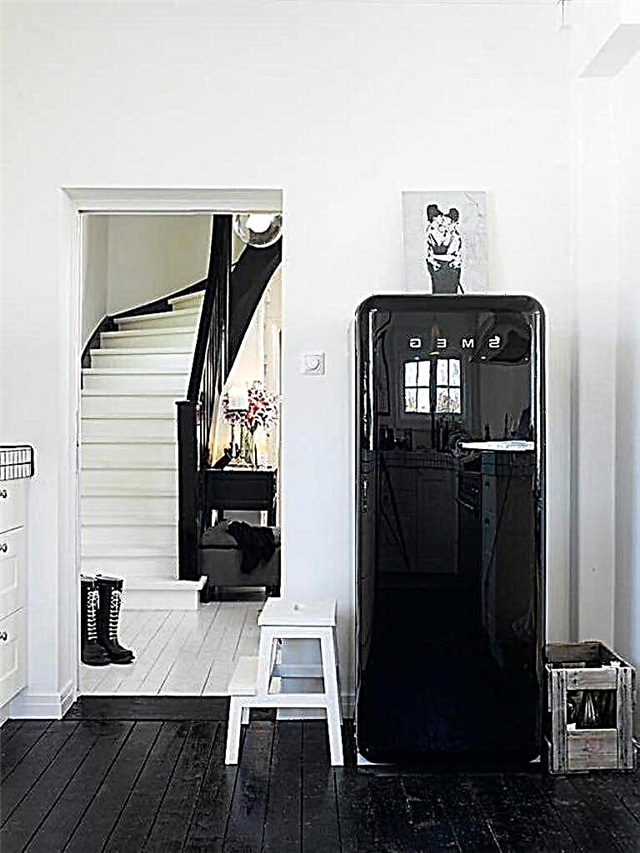
It is only important to remember that the refrigerator should not stand close to the wall, it is important to leave a little free space so as not to disturb the air exchange processes. Additional information: This arrangement is rather a necessary measure, when there are no options at all, and will be suitable as a last resort
This is due to the fact that every time it’s quite inconvenient to walk into the corridor for groceries
Additional information: This arrangement is rather a necessary measure, when there are no options at all, and will be suitable as a last resort. This is due to the fact that every time it’s quite inconvenient to walk into the corridor for groceries.
Is it possible to take out a bulky unit on the balcony
Removing the refrigerator to the balcony is far from possible in every case. The fact is that the refrigerator does not tolerate both heat and cold in space very well, this directly affects its performance characteristics. Most often only residents of the south of the country can take out such an aggregate onto the balcony, because you can hardly find cold weather there. But you should also be afraid of overheating.
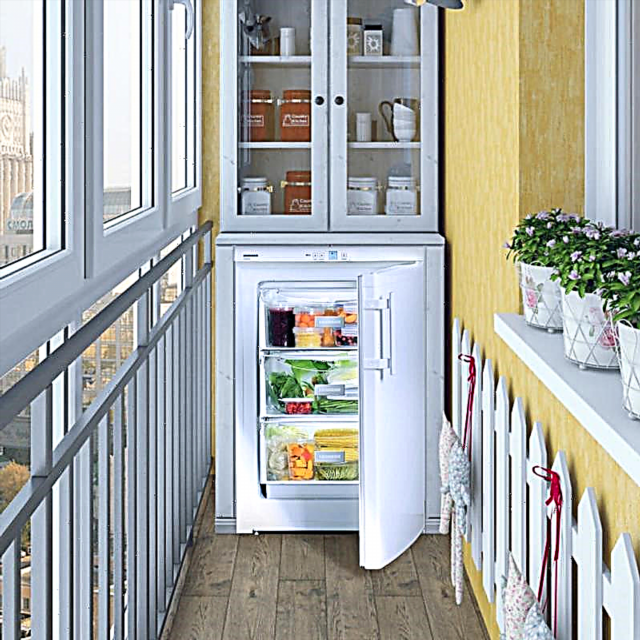
If the street is hot above 30 degrees, then the refrigerator located on the balcony will quickly fail.
However, there are models of a special climate class - they are not afraid of the cold. The same can be said for refrigerators equipped with no frost system
But in the case of such models, it is important that the balcony is insulated and protected from moisture using a ventilation system. The technique also needs to be hidden from sunlight.
Compactness
If you have the maximum capacity in priority, then it is better to give preference to a freestanding model. The volume of the built-in refrigerator and freezer is almost always less than that of a freestanding one, but it takes up much less space.
In addition, even visually, a kitchen with built-in appliances seems more spacious than with a stationary one, since space is not crushed by variegated surfaces. For a small kitchen, this is a big bonus.

Built-in refrigerator in a small kitchen in Khrushchev

Built-in refrigerator in the interior of a classic kitchen in Khrushchev studio
Appearance and design features
The built-in refrigerators differ from ordinary ones in that they do not have an external decorative panel. Instead, they are equipped with a device for attaching the facade. Thanks to the facades, the built-in refrigerator does not violate the stylistics of the interior.

By the way, built-in models can be installed not only in the kitchen: they can be equipped with, say, a bar, an island, a cabinet in the living room (see photo below) or built into office furniture.

Mini fridge integrated under the island countertop

Wardrobe in the living-dining room with built-in refrigerator
At the same time, even if there are several similar cabinet cabinets, it will be easy to navigate in the kitchen and find the right door by the appearance of the cabinet. In addition, in the lower part of the box with a refrigerator, as a rule, there is a grill for fresh air to the heating elements. In electronically controlled models, a panel with temperature indicators and color indicators can also be removed to the outside of the device.
Small built-in refrigerators are often located under the kitchen worktop.

Small refrigerator built-in under the countertop
Heat and sound insulation
Such refrigerators usually have additional thermal insulation and lower noise levels compared to stand-alone models. In particular, they are quieter than free-standing ones, since the outer panels of the kitchen cabinet help achieve greater sound insulation.
Built-in refrigerators are on average more expensive than conventional ones - manufacturers explain this by the complexity of the design and the cost of additional thermal insulation. Prices for single-chamber models without additional functions start from 20 000 rubles, while the cost of models with the maximum number of options and electronic control often exceeds 50 000 rubles.
The cost depends on the number of doors and cameras, the internal structure and the availability of special coatings for better storage of products. Similar features are most often found in premium built-in refrigerators.
In addition, as is the case with stand-alone models, the price of an embedded model is directly proportional to its size.
Define your budget and wishes in advance in order to narrow your search and not waste time looking at models that are too expensive with additional features that do not interest you.
Before you start choosing a built-in refrigerator for its functionality, always pay attention to its dimensions.
It is best to choose a refrigerator at the same time as ordering a set of kitchen furniture.



